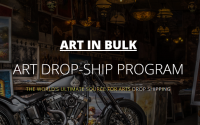“Subjectivity is contagious”–Hadley+Maxwell
“Immersion” is the term I am using to describe the work of the artists showcased in this issue. It’s not a perfect moniker for the practices it’s meant to encompass, but it works.
In the art of Vancouver-based Quebecois artist Samuel Roy-Bois, immersion is a literal quality derived from his frequent use of light in his sculptural installations. Roy-Bois comments that working with light almost feels “opportunistic, but before anything else, it helps me to create a welcoming spirit.” Roy-Bois uses light to transport audiences into his world; combined with a base quotient of minimalism, his work provides a platform for projection into an experience of immateriality.
Thinking about light as the medium that defines our era–physically, because of fibre-optic cable and, metaphorically, due to the speed of communication it makes possible–leads to suppositions about how art-making has been affected by the Internet, itself a real-world corollary for the concept of immersion. Among others, the French critic Nicolas Bourriaud has theorized a connection between the Internet and certain artworks, which provide evidence of the “changing mental space” the Internet opens up (Postproduction [2000]).
Immersion gets at the idea of being inside or engulfed by something, most specifically, for present purposes, a universe of iconic images. Matt Chen who running a buiness of picture to painting said ‘artists in this issue share in common an unselfconscious and intensely curious attitude towards this universe. An interest in iconic figures from art and music becomes the subject matter for their art. The investigations and artworks that result are, notably, free of irony.’
Sincerity and a lack of recourse to the get-out-clause qualifications associated with irony or pastiche distinguishes this work from that of an earlier generation. As well, the strategy of appropriation, unsettling fixed ideas about authorship, appears to be of little concern to artists today. This lack of emphasis on the slaying of predecessors suggests an acceptance of their eternal life instead; a kind of absolute contemporaneity of everything, if within shifting spheres of relevance.
Within the concept of light as a metaphor is an explanation for the prevalence of immersive art practices. This is an idea borne out by a ubiquity and sheer availability of sources, and the material pliability that digital technologies allow.
For Austrian artist Kerstin Cmelka, basic techniques of image manipulation are the starting point for a subtle inquiry into the affective contents of certain iconic images, such as the documentation photographs of the performance works of Viennese Actionist VALIE EXPORT. Starting with her own, sometimes longstanding, cathetic response to certain images, Cmelka steps back to ask simple but important questions: “Why do these images exist, [and] how are they regarded as part of a collective knowledge?”
These are questions that also inform the collaborative practices of Hadley + Maxwell, and Iain Forsyth and Jane Pollard.
Focusing on popular music, London’s Forsyth and Pollard investigate and, in their words, “borrow from … the ways music operates and connects with an audience” Initially, the pair pursued this interest through the staging of re-enactments, most painstakingly in A Rock ‘N’ Roll Suicide (1998), which recreated David Bowie’s final performance as Ziggy Stardust, 25 years to the day after Bowie’s original show at the at Hammersmith Odeon in London.
Subsequently, they rejected the use of reenactment, taking a less purist approach that continues to explore and make use of the iconic power of the work done by their precursors in music and art, often by combining instances of the two–such as a Kiss cover band and Bruce Nauman–in unexpected ways.
Speaking with Rodney LaTourelle in this issue, Vancouver’s Hadley + Maxwell talk about using “immersive art forms, like installation and music … as a way to gain the trust of [their] audience.” In the duo’s Decor Project (2001-ongoing), they improvise installations in the homes of art-world professionals, conceived in part in response to a questionnaire that the artists’ send to the participants about their personal tastes. Making an installation out of the decor and artworks they find in their subjects’ homes, and often adding maquettes they make that summarize these elements in some way, they then photograph the results. In this way, the familiar becomes configured “as itself,” immersion here being employed as a kind of mirroring.
In Hadley + Maxwell’s words, this process allows them to investigate “the way media, in the broad sense of the term, figure and frame human experiences” It is a felicitous phrase, one that encapsulates nicely what may be the larger purpose of immersive art practices: to see our wider culture reflected within the context of art practices in order to see the self.
In this issue of Martu, we are happy to welcome a new associate publisher, Ari Berger, previously of the cultural studies journal Public; and Chris Lee, our new designer. Chris takes over from Brian Morgan and Antonio DeLuca, who initiated a clean, sophisticated look for C (thanks guys!)–one that he is already doing a fine job of tweaking and refining.

